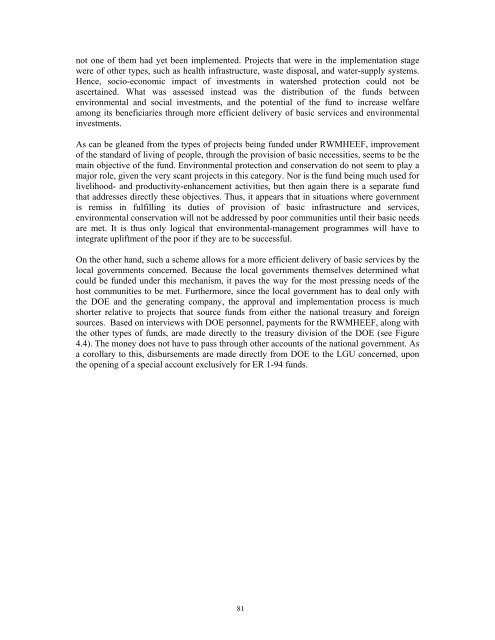Developing pro-poor markets for environmental services in the ...
Developing pro-poor markets for environmental services in the ...
Developing pro-poor markets for environmental services in the ...
You also want an ePaper? Increase the reach of your titles
YUMPU automatically turns print PDFs into web optimized ePapers that Google loves.
not one of <strong>the</strong>m had yet been implemented. Projects that were <strong>in</strong> <strong>the</strong> implementation stage<br />
were of o<strong>the</strong>r types, such as health <strong>in</strong>frastructure, waste disposal, and water-supply systems.<br />
Hence, socio-economic impact of <strong>in</strong>vestments <strong>in</strong> watershed <strong>pro</strong>tection could not be<br />
ascerta<strong>in</strong>ed. What was assessed <strong>in</strong>stead was <strong>the</strong> distribution of <strong>the</strong> funds between<br />
<strong>environmental</strong> and social <strong>in</strong>vestments, and <strong>the</strong> potential of <strong>the</strong> fund to <strong>in</strong>crease welfare<br />
among its beneficiaries through more efficient delivery of basic <strong>services</strong> and <strong>environmental</strong><br />
<strong>in</strong>vestments.<br />
As can be gleaned from <strong>the</strong> types of <strong>pro</strong>jects be<strong>in</strong>g funded under RWMHEEF, im<strong>pro</strong>vement<br />
of <strong>the</strong> standard of liv<strong>in</strong>g of people, through <strong>the</strong> <strong>pro</strong>vision of basic necessities, seems to be <strong>the</strong><br />
ma<strong>in</strong> objective of <strong>the</strong> fund. Environmental <strong>pro</strong>tection and conservation do not seem to play a<br />
major role, given <strong>the</strong> very scant <strong>pro</strong>jects <strong>in</strong> this category. Nor is <strong>the</strong> fund be<strong>in</strong>g much used <strong>for</strong><br />
livelihood- and <strong>pro</strong>ductivity-enhancement activities, but <strong>the</strong>n aga<strong>in</strong> <strong>the</strong>re is a separate fund<br />
that addresses directly <strong>the</strong>se objectives. Thus, it appears that <strong>in</strong> situations where government<br />
is remiss <strong>in</strong> fulfill<strong>in</strong>g its duties of <strong>pro</strong>vision of basic <strong>in</strong>frastructure and <strong>services</strong>,<br />
<strong>environmental</strong> conservation will not be addressed by <strong>poor</strong> communities until <strong>the</strong>ir basic needs<br />
are met. It is thus only logical that <strong>environmental</strong>-management <strong>pro</strong>grammes will have to<br />
<strong>in</strong>tegrate upliftment of <strong>the</strong> <strong>poor</strong> if <strong>the</strong>y are to be successful.<br />
On <strong>the</strong> o<strong>the</strong>r hand, such a scheme allows <strong>for</strong> a more efficient delivery of basic <strong>services</strong> by <strong>the</strong><br />
local governments concerned. Because <strong>the</strong> local governments <strong>the</strong>mselves determ<strong>in</strong>ed what<br />
could be funded under this mechanism, it paves <strong>the</strong> way <strong>for</strong> <strong>the</strong> most press<strong>in</strong>g needs of <strong>the</strong><br />
host communities to be met. Fur<strong>the</strong>rmore, s<strong>in</strong>ce <strong>the</strong> local government has to deal only with<br />
<strong>the</strong> DOE and <strong>the</strong> generat<strong>in</strong>g company, <strong>the</strong> ap<strong>pro</strong>val and implementation <strong>pro</strong>cess is much<br />
shorter relative to <strong>pro</strong>jects that source funds from ei<strong>the</strong>r <strong>the</strong> national treasury and <strong>for</strong>eign<br />
sources. Based on <strong>in</strong>terviews with DOE personnel, payments <strong>for</strong> <strong>the</strong> RWMHEEF, along with<br />
<strong>the</strong> o<strong>the</strong>r types of funds, are made directly to <strong>the</strong> treasury division of <strong>the</strong> DOE (see Figure<br />
4.4). The money does not have to pass through o<strong>the</strong>r accounts of <strong>the</strong> national government. As<br />
a corollary to this, disbursements are made directly from DOE to <strong>the</strong> LGU concerned, upon<br />
<strong>the</strong> open<strong>in</strong>g of a special account exclusively <strong>for</strong> ER 1-94 funds.<br />
81
















